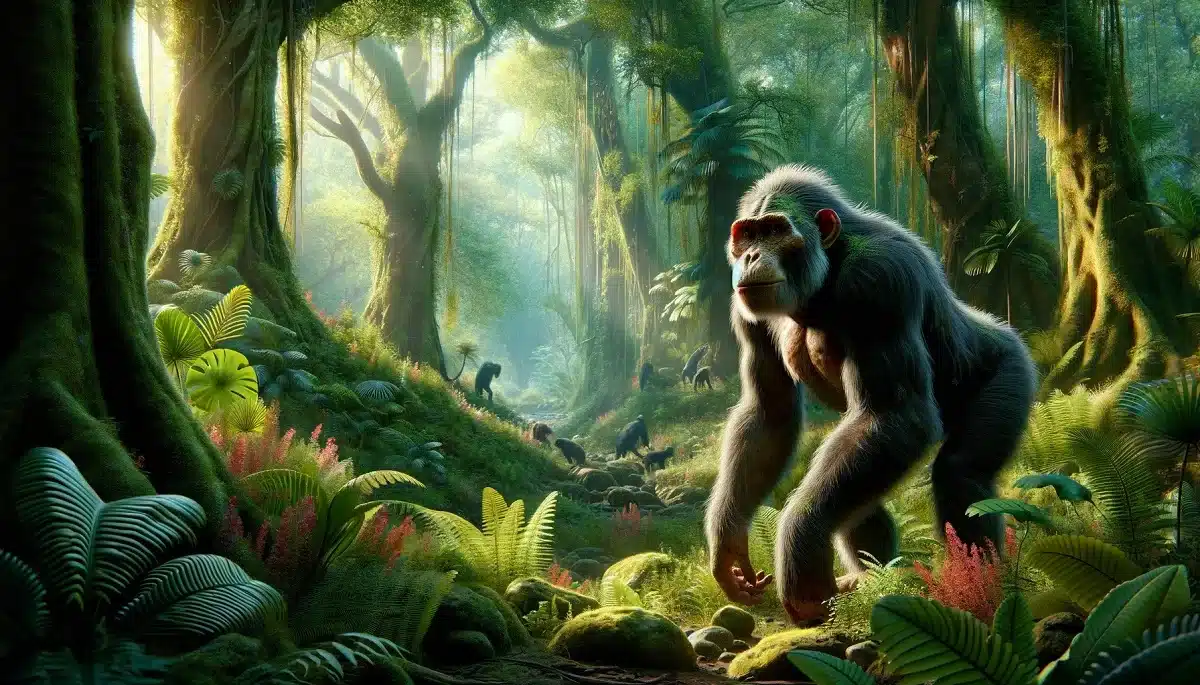Oreopithecus: A Mysterious Hominid from the Past
Oreopithecus is an extinct species of ape that lived in the Tuscany and Sardinia regions of present-day Italy during the Miocene period, approximately 9 to 7 million years ago. This mysterious primate, whose fossil remains were first discovered in coal mines in the 19th century, has been the subject of significant debate in the fields of paleoanthropology and evolutionary biology. Let’s take a look at a detailed review of the characteristics, habitat and evolutionary position of Oreopithecus.

Physical Characteristics and Living Area
Physical Characteristics of Oreopithecus
Oreopithecus is a now extinct species of ape that lived during the Miocene period, approximately 9 to 7 million years ago. Detailed studies of its physical characteristics show that this species has an anatomical structure that is both unique and unusual:
- Size and Weight:
- Oreopithecus had an average height of 1 meter and a weight of 30-35 kilograms. These dimensions make it a medium-sized primate.
- Tooth Structure:
- The dentition suggests that this primate ate both a herbivorous and partially carnivorous diet. Especially the structure of its back teeth (molars) was strong enough to break hard-shelled fruits and seeds.
- Skeletal Structure:
- The pelvic (hip girdle) structure of Oreopithecus is of particular interest and indicates the ability to stand upright on two legs and perhaps walk. However, it is still controversial whether this primate spent all its time on two legs.
- Its long arms and prehensile hands indicate that Oreopithecus was able to live effectively in trees, indicating that it had an arboreal lifestyle.
- Skull and Brain Size:
- The skull structure indicates a relatively small brain size. Although this suggests that Oreopithecus did not have high levels of intelligence, it does indicate that it had sufficient skills in social behavior and environmental adaptation.
Habitat of Oreopithecus
Oreopithecus lived mainly in the Tuscany and Sardinia regions of present-day Italy. These regions were island-shaped during the Miocene period and offered different ecological conditions:
- Habitat:
- Their habitat was covered in dense forests and swamps. These environments provided Oreopithecus with both a food source and protection from predators.
- Oreopithecus likely had a lifestyle that spent time both on the ground and in trees, indicating that it evolved both arboreal and terrestrial adaptations.
- Ecological Niche:
- Oreopithecus filled its niche in its habitat by adapting to specific food sources and protection strategies. Its adaptation to its environment is supported by different nutrition and mobility abilities.
The physical characteristics and habitat of Oreopithecus provide valuable information about what kind of environment this ancient primate lived in and what kind of evolutionary process it went through. The surviving fossil record helps us understand the life history of this unique primate and sheds light on the evolutionary history of humans.
Oreopithecus Evolutionary Position and Scientific Debates
The evolutionary position of Oreopithecus has long been a matter of debate among scientists. While some researchers suggest that this primate developed bipedal walking and may have occupied an important place in the evolutionary tree of humans, others argue that this feature of Oreopithecus was an adaptation and represented a side branch rather than a direct ancestor to humans.
Oreopithecus Fossil Discoveries and Oreopithecus in the Light of Science
Fossil remains of Oreopithecus were discovered primarily in the Baccinello coal mines in Italy. These fossils have provided scientists with valuable information about the anatomy and lifestyle of Oreopithecus. In particular, fossils such as the skull, teeth, and pelvic girdle contain clues about the physical structure and potential behaviors of this primate.
Legacy of Oreopithecus
Oreopithecus is a mysterious group of fossils that raise important questions about primate evolution and the lifestyles of our hominid ancestors. Fossils of this ancient primate shed light on millions of years ago and help us understand the complex and intricate paths of evolution. Future research will continue to provide further insight into the evolutionary biology and human origins of Oreopithecus. This is a scientific journey that helps us understand not only our past, but also who we are and where we might be going.





